Venus Statistics
| Planetary Symbol: |
 |
Name in Roman/Greek Mythology: |
Venus/Aphrodite |
| Diameter: |
12,104 km (7,522 miles) |
Rotation Period about Axis: |
243 days (retrograde) |
| Mass: |
4.87x10^24 kilograms (0.82 x Earth's) |
Revolution Period about the Sun: |
0.62 years |
| Density: |
5,243 kg/m^3 |
Tilt of Axis: |
177-178o |
| Minimum Distance from Sun: |
108 million km
(67 million miles) |
Surface Gravity: |
8.87 m/s^2 (0.90 x Earth's) |
| Maximum Distance from Sun: |
109 million km
(68 million miles) |
Average Temperature (C/F): |
457o C (855o F) |
| Orbital Semimajor Axis: |
0.72 AU (Earth=1 AU) |
Average Surface Temperature (K): |
730K |
| Minimum Distance from Earth: |
40 million km
(25 million miles) |
Satellites: |
0 |
 Venus Image Archive
Venus Image Archive
 Comparative Planetary Statistics -- in table form
Comparative Planetary Statistics -- in table form
 Comparative Orbital Statistics -- in table form
Comparative Orbital Statistics -- in table form
 Actual Distance to Earth
Actual Distance to Earth
You might also be interested in:
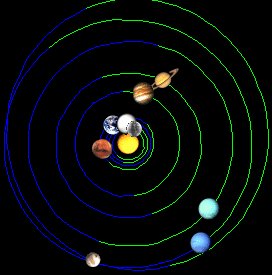
There is a really neat internet program called Solar System Live that shows where all of the planets and the Sun are. If you go to that page, you'll see an image similar to the one on the left. Below the
...more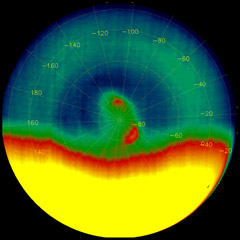
A vortex is a swirling, circular movement of air and clouds... like in a tornado or hurricane. The plural form of vortex is "vortices". The planet Venus has vortices in its atmosphere above each of its
...more
Venus is the second planet from the Sun, and is Earth's closest neighbor in the solar system. Venus is the brightest object in the sky after the Sun and the Moon, and sometimes looks like a bright star
...more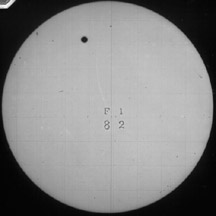
Sometimes the planet Venus goes between Earth and the Sun. From Earth it looks like a black dot moves across the Sun. Astronomers call this a transit of Venus. Transits of Venus don't happen very often.
...more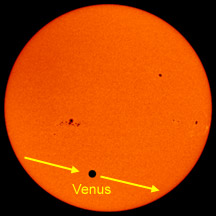
Sometimes the planet Venus gets between Earth and the Sun. When it does, we see a black dot move across the Sun. The black dot is Venus. Astronomers have a name for this. They call it a "transit"
...more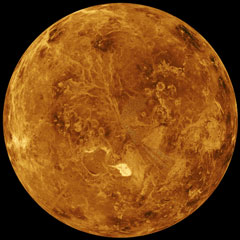
Venus is the hottest planet in our Solar System. On Earth, places near the equator are hot. Places near the poles are cold. On Venus, it is really hot everywhere... even at the North and South Poles. Venus
...more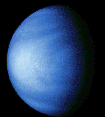
The following may be the history of Venus. at the conclusion of forming it continued to be hit with leftover material. Venus warmed from inside, and separated into layers. Because Venus is close to the
...more
This is an example of a volcanic tick.
...more

 Comparative Planetary Statistics -- in table form
Comparative Planetary Statistics -- in table form
 Comparative Orbital Statistics -- in table form
Comparative Orbital Statistics -- in table form


 Venus Image Archive
Venus Image Archive











